Myocardial Function & Deformation
Myocardial Function & Deformation
Oral
Oral
Cardiovascular
Thursday, 16 May 2019
| Room 518A-C | 08:15 - 10:15 | Moderators: Christopher Francois |
08:15 |
1080. |
Fetal Cardiac MRI using Self-gating with a Cartesian K-space Trajectory
Henrik von Kleist, Natalie Copeland, P. Ellen Grant, Wayne Tworetzky, Andrew Powell, Mehdi H. Moghari
Fetal cardiac MRI may be a useful compliment to echocardiography given its ability to measure blood flow and produce quality images independent of body habitus. Fetal cardiac MRI is, however, technically challenging since the fetal electrocardiogram signal cannot be sampled for cardiac gating. Self-gating is a method to extract the cardiac gating signal directly from MRI data, and its performance has been validated on adults. In this work, we investigated the feasibility of using self-gating for fetal cardiac MRI and show the results from three pregnant volunteers.
|
| 08:27 |
1081. 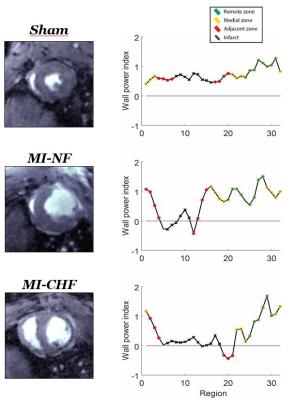 |
Regional Power Ratio: a noninvasive index of regional myocardial function
Emil Espe, Lili Zhang, Ivar Sjaastad
Detailed understanding of the regional mechanical response to myocardial infarction (MI) is currently incomplete. Strain, which is most widely used for evaluating regional function, does not account for differences in loading conditions. Regional work and power, however, take load into account, but requires pressure measurement or estimation. Here, we present a noninvasive index of regional function, Regional Power Ratio (RPR), which allows comparison of the instantaneous power generated by different regions in the myocardium. We use RPR to investigate the regional dispersion of function in the MI heart, and compare to analysis of regional work.
|
| 08:39 |
1082. 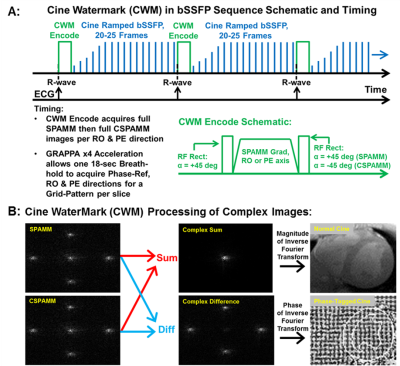 |
Balanced SSFP Highly Accelerated Cine ‘Watermark’ Quantifies 2D Myocardial Strain with comparison to 2D Spiral Cine DENSE
Ronald Beyers, Nouha Salibi, Thomas Denney
Cardiac MRI (CMR) myocardial tagging enables quantification of myocardial strain. However, tagging remains limited to a research context due to the time-intensive analysis and need to run multiple sequences. CMR sequences must be fast and efficient. We previously developed low-acceleration FLASH and Balanced-SSFP versions of Cine ‘Watermark’ (CWM) that acquire normal cine magnitude images plus ‘hidden’ (via phase) cardiac strain data for calculating myocardial strain. Here we present a highly x4 accelerated bSSFP CWM with improved performance and scan efficiency. The bSSFP CWM is demonstrated in human subjects at 3T and its performance is compared to 2D Spiral Cine DENSE.
|
| 08:51 |
1083. 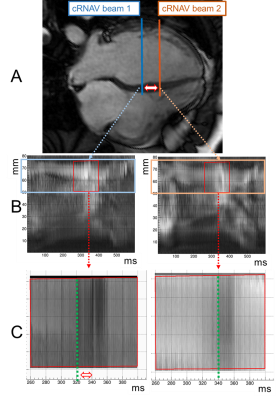 |
Shear wave MR elastography using intrinsic cardiac motion for the non-invasive evaluation of myocardial stiffness: initial results in volunteers and HCM patients.
Marian Troelstra, Emma Burnhope, Jurgen Runge, Alessandro Polcaro, Torben Schneider, Jordi Martorell, David Nordsletten, Tevfik Ismail, Ralph Sinkus
Imaging myocardial stiffness provides useful clinical information in various cardiac conditions and diseases. We developed an intrinsic shear wave MRE method for determining shear wave speed in the interventricular septum using an adapted motion-sensitised pencil beam respiratory navigator sequence (cRNAV). Time of flight between two imaged locations in the basal and apical septum was used to estimate flexural shear wave velocity. Initial testing provided promising results in healthy volunteers and two patients with hypertrophic cardiomyopathy (HCM).
|
| 09:03 |
1084. 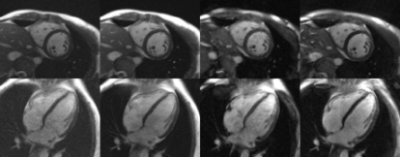 |
Long TR bSSFP Cardiac Cine Imaging at Low Field (0.55T) using EPI and Spiral Sequences for Improved Sampling Efficiency
Matthew Restivo, Rajiv Ramasawmy, Daniel Herzka, Adrienne Campbell-Washburn
One key benefit of low field MRI (0.55T) is a more homogeneous B0 field due to the scaling of susceptibility with field strength. For cardiac imaging, where balanced steady-state free precession (bSSFP) is the dominate sequence, bSSFP banding artifacts are directly related to off-resonance phase accrual over each TR. We exploit the improved homogeneity by extending the TR of the clinical bSSFP cardiac cine sequence to improve sampling efficiency and thus SNR. Using fast, efficient acquisition strategies such as EPI and spiral, we can extend the TR from 3.1 to 8 ms to improve SNR without additional banding.
|
09:15 |
1085 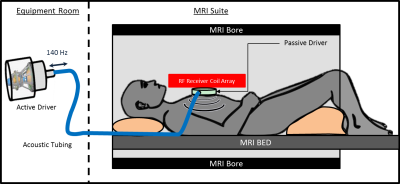 |
Changes in myocardial stiffness and damping ratio due to cardiac amyloidosis: Evaluation with magnetic resonance elastography and a novel neural network inversion Video Permission Withheld
Arvin Arani, Shivaram Arunachalam, Ian Chang, Phillip Rossman, Kevin Glaser, Joshua Trzasko, Kiaran McGee, Armando Manduca, Martha Grogan, Angela Dispenzieri, Richard Ehman, Philip Araoz, Matthew Murphy
Myocardial viscoelasticity plays an important role in cardiac function. The objective of this study is to evaluate if magnetic resonance elastography (MRE) can detect differences in myocardial stiffness (µ) and damping ratio (ζ) in cardiac amyloidosis patients. Twenty-six patients with cardiac amyloidosis and 96 healthy volunteers were enrolled. The mean left ventricular µ was significantly higher (p < 0.01) and ζ was significantly lower (p<0.01) in cardiac amyloidosis patients (median µ: 19.5 kPa, median ζ: 0.15) compared to normal controls (median µ: 15.7 kPa, median ζ: 0.18). These results motivate future investigation of cardiac MRE in different patient cohorts.
|
| 09:27 |
1086. 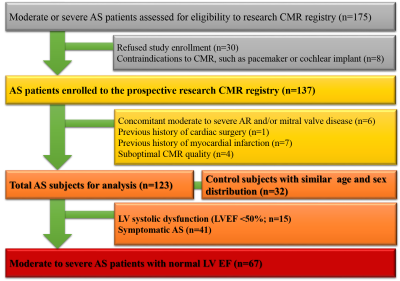 |
Predictive Value of Cardiac Magnetic Resonance Feature Tracking for Clinical Cardiac Events in Asymptomatic Aortic Stenosis Patients with Normal Ejection Fraction
MOON YOUNG KIM, Eun-Ah Park, Whal Lee, Seung-Pyo Lee
Using cardiac magnetic resonance feature tracking, Global longitudinal and radial peak strains (PS) are correlated with degree of aortic stenosis (AS) and can reflect cardiac dysfunction. Furthermore, global longitudinal PS may be one of the most potent predictive factor for clinical cardiac event in asymptomatic AS patients with normal ejection fraction.
|
| 09:39 |
1087. 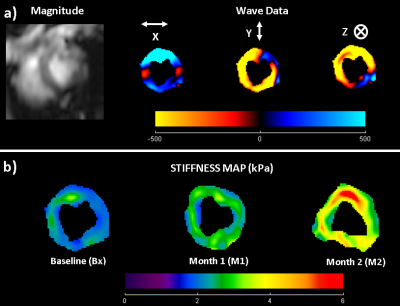 |
Comparing Myocardial Stiffness using MRE with Ex-vivo histopathology results in Heart Failure with Preserved Ejection Fraction Porcine Model
Prateek Kalra, Matthew Joseph, Jordan Williams, Peter Mohler , Richard White, Arunark Kolipaka
Cardiovascular abnormalities that induce heart failure with preserved ejection fraction(HFpEF) eventually increases left ventricular(LV) myocardial stiffness(MS). Currently, MS is measured using LV catheterization. However, this procedure is invasive and only gives global measurements. Previous study has shown feasibility of cardiac Magnetic Resonance Elastography(MRE) in determining MS and validated against LV catheterization. Histopathology of ex-vivo samples can provide fibrosis content. Aim of this study is to estimate MS using cardiac MRE in HFpEF porcine model and validate against histopathology results. Preliminary study demonstrate increased LV stiffness correlates well with increase in fibrosis from histopathology in diseased samples when compared to healthy.
|
| 09:51 |
1088. 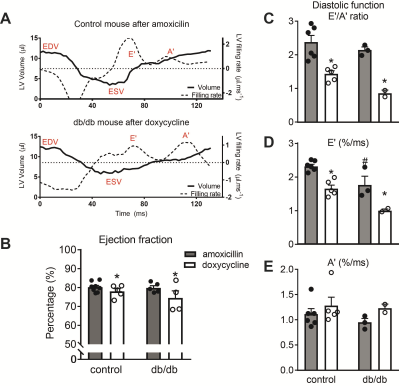 |
The antibiotic doxycycline compromises cardiac mitochondrial and contractile function in diabetic mice
Rob Wust, Bram Coolen, Vida Alizadeh Tazehkandi, Mariah Daal, Riekelt Houtkooper , Gustav Strijkers
Given the evolutionary similarities between the bacterial and mitochondrial protein synthesis machinery, we tested the hypothesis that the widely used antibiotic doxycycline reduces mitochondrial function, and results in cardiac contractile dysfunction. Indeed, doxycycline exposure resulted in a dose-dependent reduction in maximal uncoupled mitochondrial respiration in cultured H9C2 cells. Maximal mitochondrial respiration was also reduced in mice treated with doxycycline. MRI of treated mice revealed contractile dysfunction as evidenced by marked diastolic and a mild systolic dysfunction. Moreover, doxycycline exacerbated mitochondrial and contractile dysfunction in animals with type 2 diabetes mellitus.
|
| 10:03 |
1089. 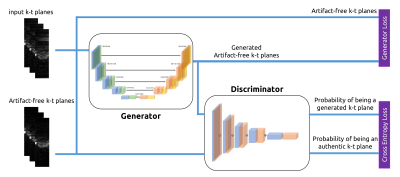 |
DAS-Net: A Generative Adversarial Net to Suppress Artifact-Generating Echoes in DENSE MRI
Mohammad Abdishektaei, Xue Feng, Craig Meyer, Frederick Epstein
In DENSE, displacement-encoded stimulated echoes are acquired with an artifact-generating signal due to T1 relaxation. Phase-cycling acquisitions are generally used to suppress the artifact-generating echoes which can result in imperfect artifact suppression when there is motion between the two acquisitions. To avoid this problem, a generative adversarial convolutional neural network (DAS-Net) is proposed to suppress the artifacts from a single acquisition. DAS-Net was trained on a DENSE dataset acquired from healthy volunteers. Results show that DAS-Net can effectively suppress the artifact-generating echoes and has the potential to obviate the need for phase-cycling acquisitions
|
 Back to Program-at-a-Glance |
Back to Program-at-a-Glance |  Back to Top
Back to Top